Study on Optimization of Initial Support for a Tunnel in the Fracture Zone Based on the Strength Reduction Method
Abstract
:1. Introduction
2. Analysis of the Deformation of the Chunxuan Road Tunnel in the Fracture Zone
2.1. Project Profile
2.2. On-Site Deformation Analysis
3. Analysis of Tunnel Support Optimization Based on the Strength Reduction Method
3.1. Numerical Simulation Application of the Strength Reduction Method
- where σ0 is the initial uniaxial compressive strength, MPa;
- σ1 is the ultimate uniaxial compressive strength, MPa;
- K is the strength reduction coefficient.
- where c0 is the initial cohesion, MPa;
- c1 is the ultimate cohesion, MPa;
- φ0 is the initial internal friction angle, °;
- φ1 is the ultimate internal friction angle, °.
3.2. The Model for Numerical Calculation
3.3. Simulation Analysis of the Original Initial Support Scheme
3.4. Analysis of Steel Arch Frame Parameter Optimization
3.5. Analysis of Bolt Parameter Optimization
3.6. Analysis of Lining Parameter Optimization
4. On-Site Application of the Optimization Scheme
5. Conclusions
Author Contributions
Funding
Institutional Review Board Statement
Informed Consent Statement
Data Availability Statement
Acknowledgments
Conflicts of Interest
References
- Bai, C.; Xue, Y.; Qiu, D.; Su, M.; Ma, X.; Liu, H. Analysis of Factors Affecting the Deformation of Soft Rock Tunnels by Data Envelopment Analysis and a Risk Assessment Model. Tunn. Undergr. Space Technol. 2021, 116, 104111. [Google Scholar] [CrossRef]
- Chen, J.; Liu, W.; Chen, L.; Luo, Y.; Li, Y.; Gao, H.; Zhong, D. Failure Mechanisms and Modes of Tunnels in Monoclinic and Soft-Hard Interbedded Rocks: A Case Study. Ksce J. Civ. Eng. 2020, 24, 1357–1373. [Google Scholar] [CrossRef]
- Tomanovic, Z. Effects of the Soft Rock Pre-consolidation on Time-dependent Deformations Around the Tunnel Excavation. Teh. Vjesn.-Tech. Gaz. 2015, 22, 401–406. [Google Scholar] [CrossRef]
- Guo, X.; Zhu, Y.; Tan, Z.; Li, L.; Li, A.; Yan, Y.-T. Research on Support Method in Soft Rock Tunnel Considering the Rheological Characteristics of Rock. Arab. J. Geosci. 2021, 14, 2703. [Google Scholar] [CrossRef]
- Sun, X.; Zhang, B.; Gan, L.; Tao, Z.; Zhao, C. Application of Constant Resistance and Large Deformation Anchor Cable in Soft Rock Highway Tunnel. Adv. Civ. Eng. 2019, 2019, 4347302. [Google Scholar] [CrossRef] [Green Version]
- Chen, Z.; He, C.; Wang, J.; Ma, C. Time-dependent Squeezing Deformation Mechanism of Tunnels in Layered Soft-rock Stratum Under High Geo-stress. J. Mt. Sci. 2021, 18, 1371–1390. [Google Scholar] [CrossRef]
- Wu, Z.; Zhang, B.; Weng, L.; Liu, Q.; Wong, L.N.Y. A New Way to Replicate the Highly Stressed Soft Rock: 3D Printing Exploration. Rock Mech. Rock Eng. 2020, 53, 467–476. [Google Scholar] [CrossRef]
- Mu, W.; Li, L.; Chen, D.; Wang, S.; Xiao, F. Long-term Deformation and Control Structure of Rheological Tunnels Based on Numerical Simulation and On-site Monitoring. Eng. Fail. Anal. 2020, 118, 104928. [Google Scholar] [CrossRef]
- Chen, Z.; He, C.; Xu, G.; Ma, G.; Wu, D. A Case Study on the Asymmetric Deformation Characteristics and Mechanical Behavior of Deep-Buried Tunnel in Phyllite. Rock Mech. Rock Eng. 2019, 52, 4527–4545. [Google Scholar] [CrossRef]
- Sun, X.; Zhao, C.; Tao, Z.; Kang, H.; He, M. Failure Mechanism and Control Technology of Large Deformation for Muzhailing Tunnel in Stratified Rock Masses. Bull. Eng. Geol. Environ. 2019, 80, 4731–4750. [Google Scholar] [CrossRef]
- Wu, K.; Shao, Z. Study on the Effect of Flexible Layer on Support Structures of Tunnel Excavated in Viscoelastic Rocks. J. Eng. Mech. 2019, 145, 04019077. [Google Scholar] [CrossRef]
- Chen, Z.; He, C.; Yang, W.; Guo, W.; Li, Z.; Xu, G. Impacts of Geological Conditions on Instability Causes and Mechanical Behavior of Large-scale Tunnels: A Case Study from the Sichuan-tibet Highway, China. Bull. Eng. Geol. Environ. 2020, 79, 3667–3688. [Google Scholar] [CrossRef]
- Li, G.; Hu, Y.; Tian, S.; Weibin, M.; Huang, H.-L. Analysis of Deformation Control Mechanism of Prestressed Anchor on Jointed Soft Rock in Large Cross-section Tunnel. Bull. Eng. Geol. Environ. 2021, 80, 9089–9103. [Google Scholar] [CrossRef]
- Tan, Z.; Li, S.; Yang, Y.; Wang, J. Large Deformation Characteristics and Controlling Measures of Steeply Inclined and Layered Soft Rock of Tunnels in Plate Suture Zones. Eng. Fail. Anal. 2022, 131, 105831. [Google Scholar] [CrossRef]
- Cao, C.; Shi, C.; Lei, M.; Yang, W.; Liu, J. Squeezing Failure of Tunnels: A Case Study. Tunn. Undergr. Space Technol. 2018, 77, 188–203. [Google Scholar] [CrossRef]
- Chu, Z.; Wu, Z.; Liu, Q.; Liu, B. Analytical Solutions for Deep-Buried Lined Tunnels Considering Longitudinal Discontinuous Excavation in Rheological Rock Mass. J. Eng. Mech. 2020, 146, 04020047. [Google Scholar] [CrossRef]
- Zhang, J.; Zhang, B. Reliability Analysis for Seismic Stability of Tunnel Faces in Soft Rock Masses Based on a 3d Stochastic Collapse Model. J. Cent. South Univ. 2019, 26, 1706–1718. [Google Scholar] [CrossRef]
- Fang, Z.; Zhu, Z.; Chen, X. Research on Construction Method and Deformation Control Technology of High Ground Stress Interbedded Soft Rock Tunnel. J. Intell. Fuzzy Syst. 2021, 40, 6175–6183. [Google Scholar] [CrossRef]
- Wu, K.; Shao, Z.; Qin, S.; Zhao, N. Mechanical Analysis of Tunnels Supported by Yieldable Steel Ribs in Rheological Rocks. Geomech. Eng. 2019, 19, 61–70. [Google Scholar]
- Liu, W.; Chen, J.; Luo, Y.; Chen, L.; Shi, Z.; Wu, Y. Deformation Behaviors and Mechanical Mechanisms of Double Primary Linings for Large-Span Tunnels in Squeezing Rock: A Case Study. Rock Mech. Rock Eng. 2021, 54, 2291–2310. [Google Scholar] [CrossRef]
- Du, D.; Dias, D.; Do, N. Effect of Surcharge Loading on Horseshoe-shaped Tunnels Excavated in Saturated Soft Rocks. J. Rock Mech. Geotech. Eng. 2021, 12, 1339–1346. [Google Scholar] [CrossRef]
- Feng, Q.; Jin, J.; Zhang, S.; Liu, W.; Yang, X.; Li, W. Study on a Damage Model and Uniaxial Compression Simulation Method of Frozen–Thawed Rock. Rock Mech. Rock Eng. 2022, 55, 187–211. [Google Scholar] [CrossRef]
- Schneider-Muntau, B.; Medicus, G.; Fellin, W. Strength Reduction Method in Barodesy. Comput. Geotech. 2018, 95, 57–67. [Google Scholar] [CrossRef]
- He, Y.; Wang, J.; Zhou, X.; He, Q.; Ai, S. Static and Stability Analyses of Pretensioned Latticed Arch Frame with Integrated Cable-Strut Arrangement. Thin-Walled Struct. 2019, 145, 106400. [Google Scholar] [CrossRef]
- Wang, Z.; Du, K.; Xie, Y.; Su, X.; Shi, Y.; Li, X.; Liu, T. Buckling Analysis of an Innovative Type of Steel-concrete Composite Support in Tunnels. J. Constr. Steel Res. 2021, 179, 106503. [Google Scholar] [CrossRef]
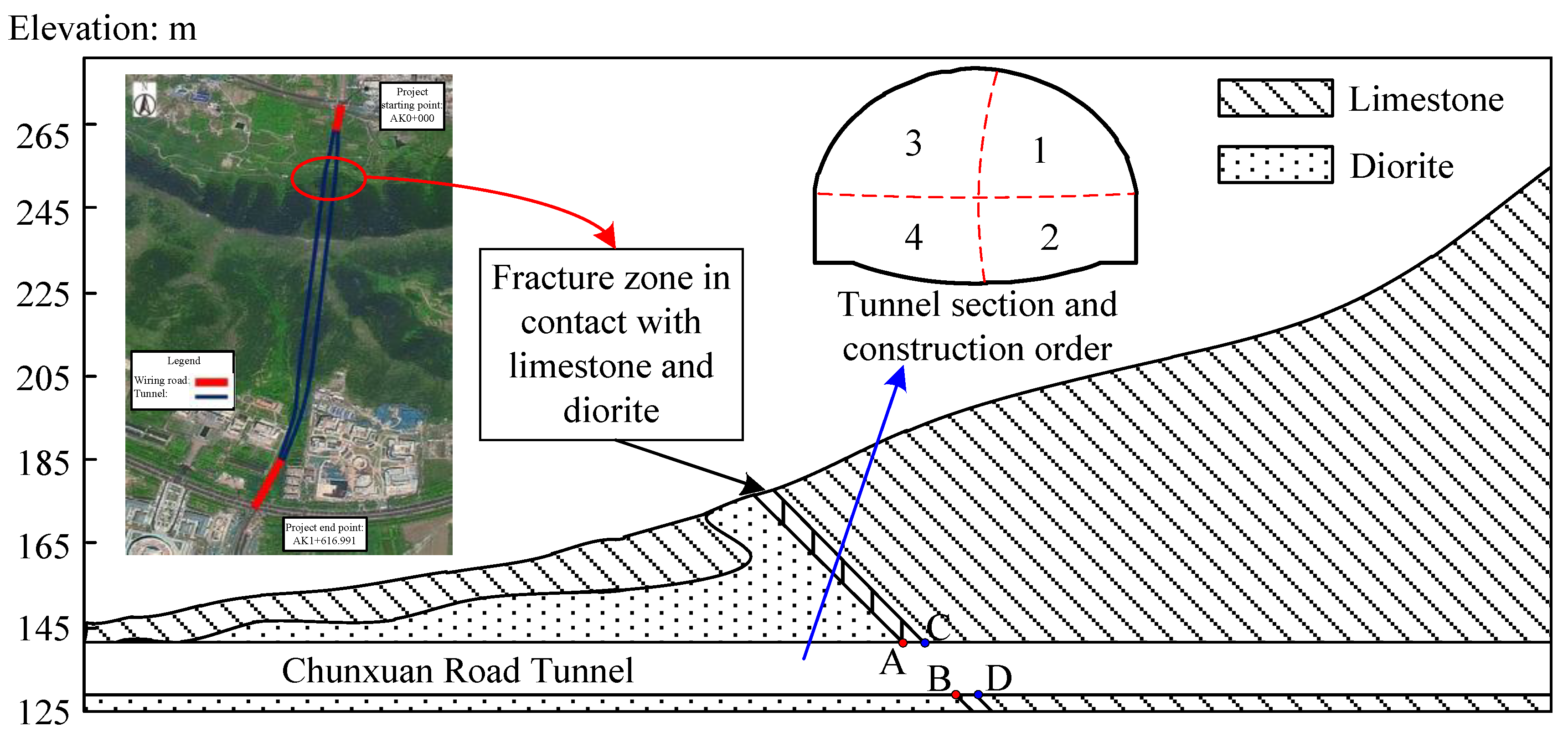


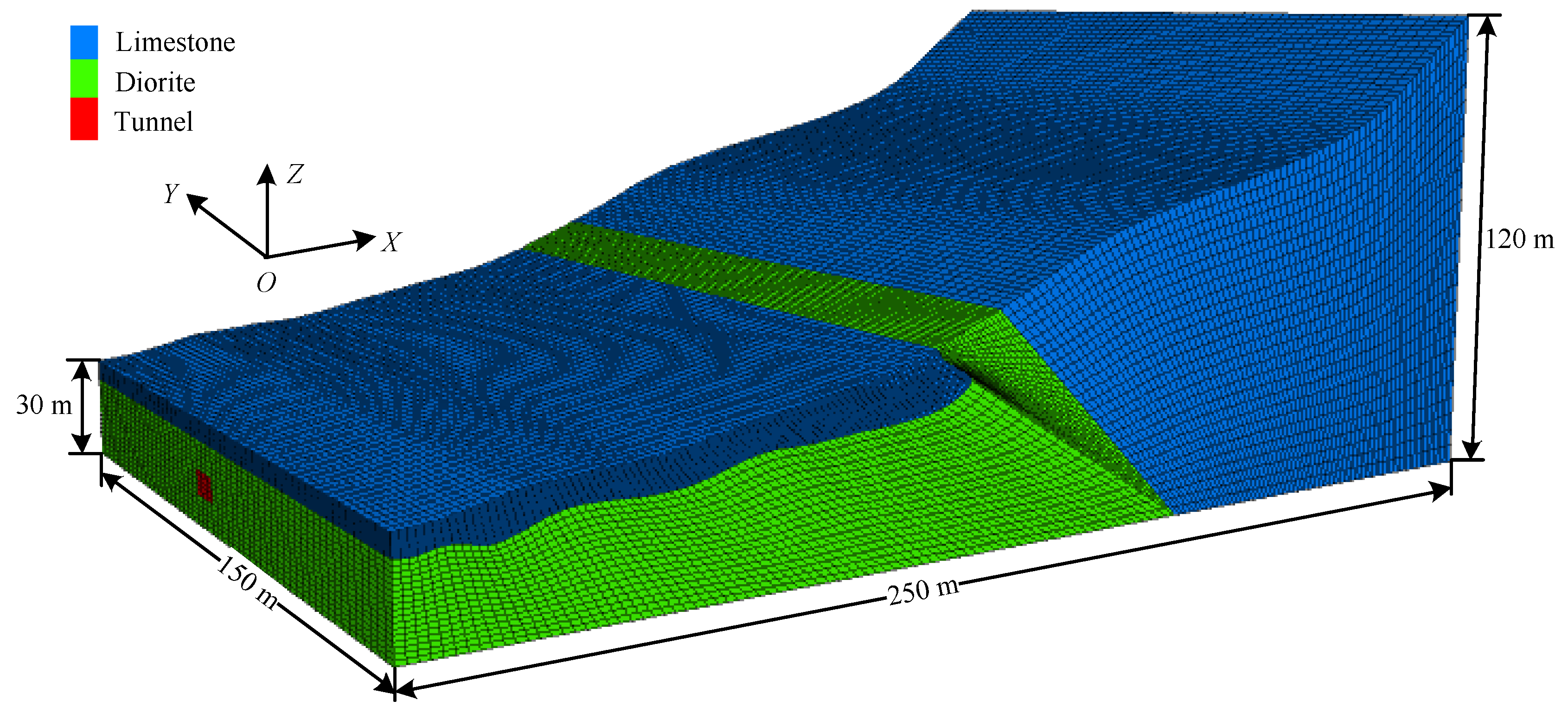
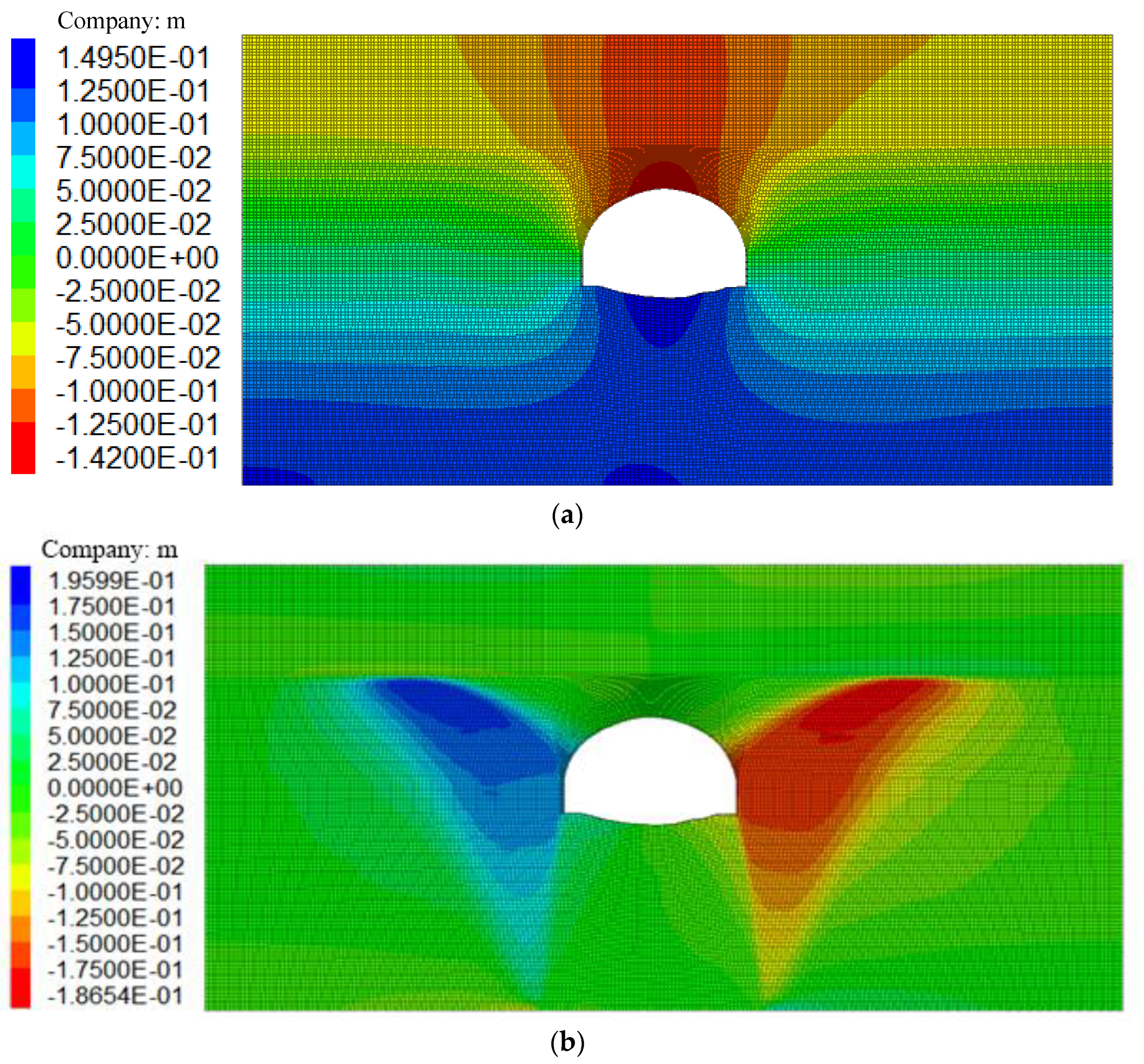

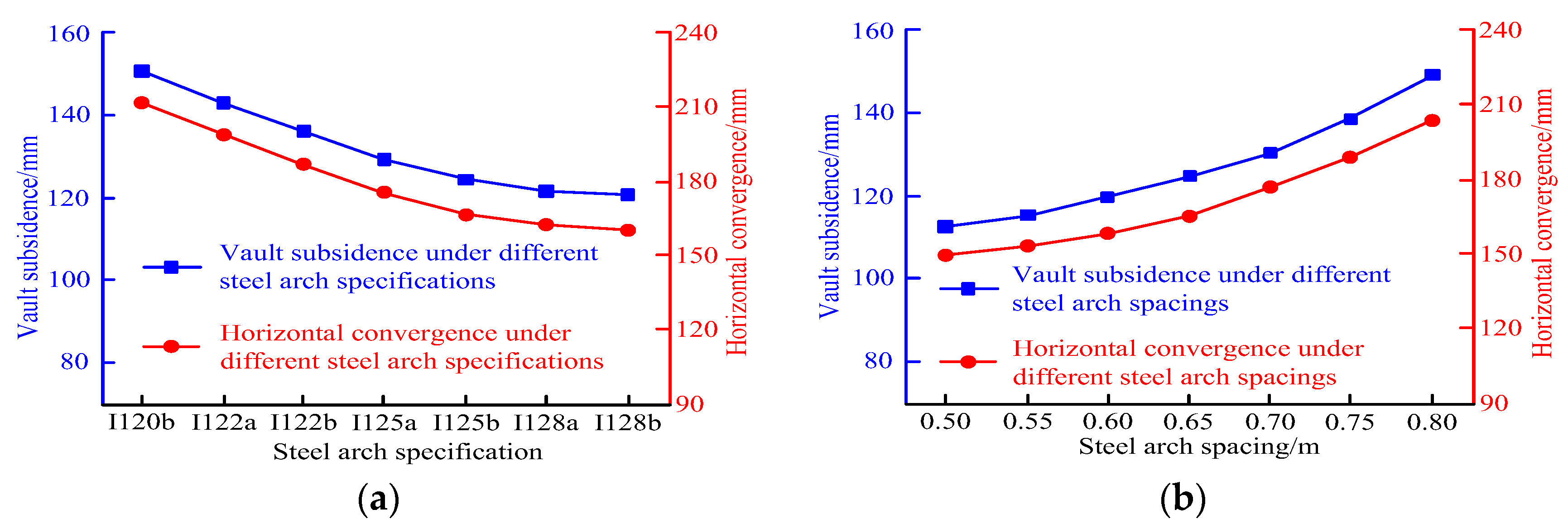
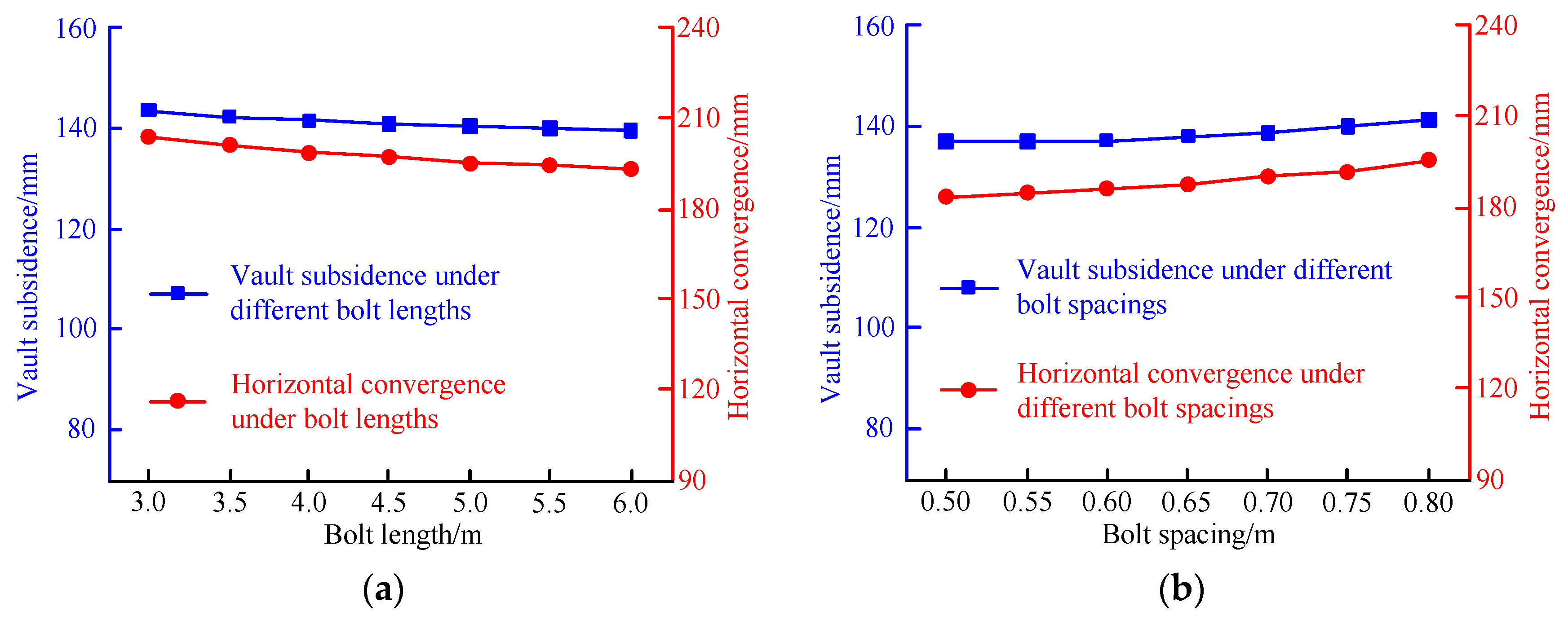
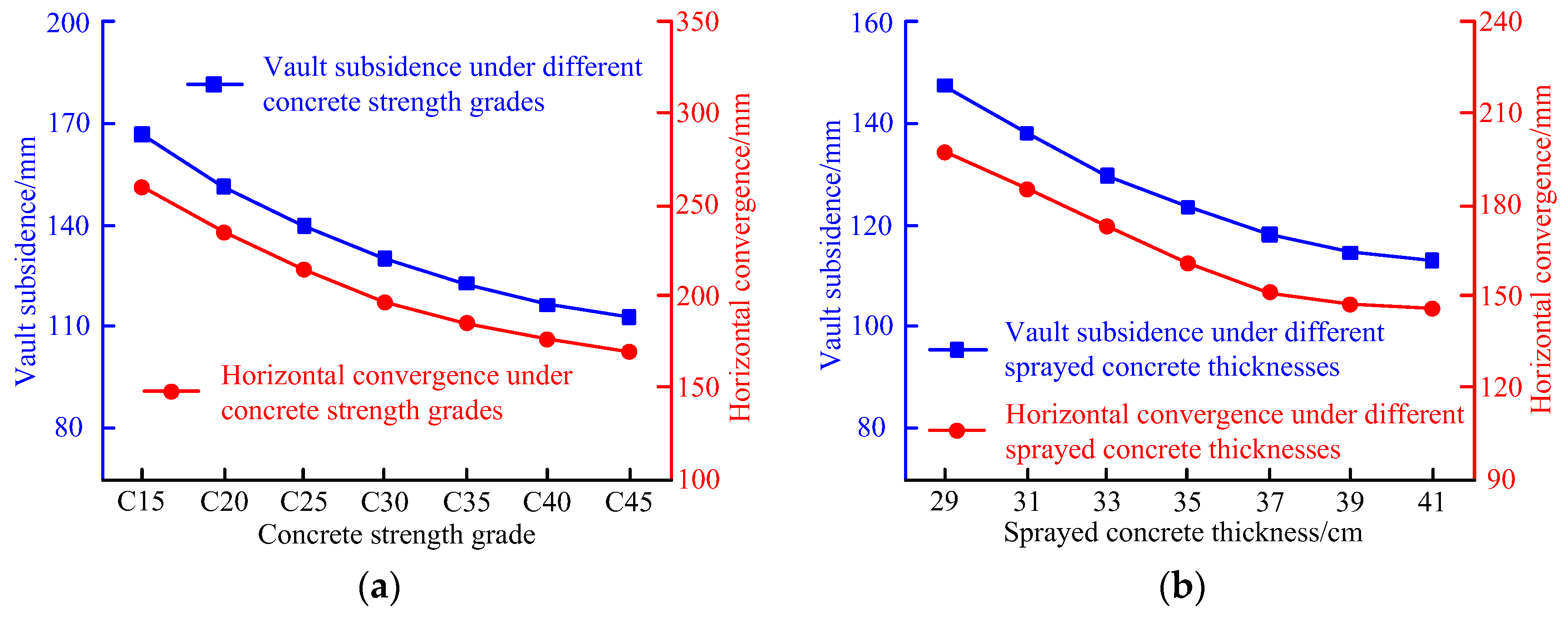
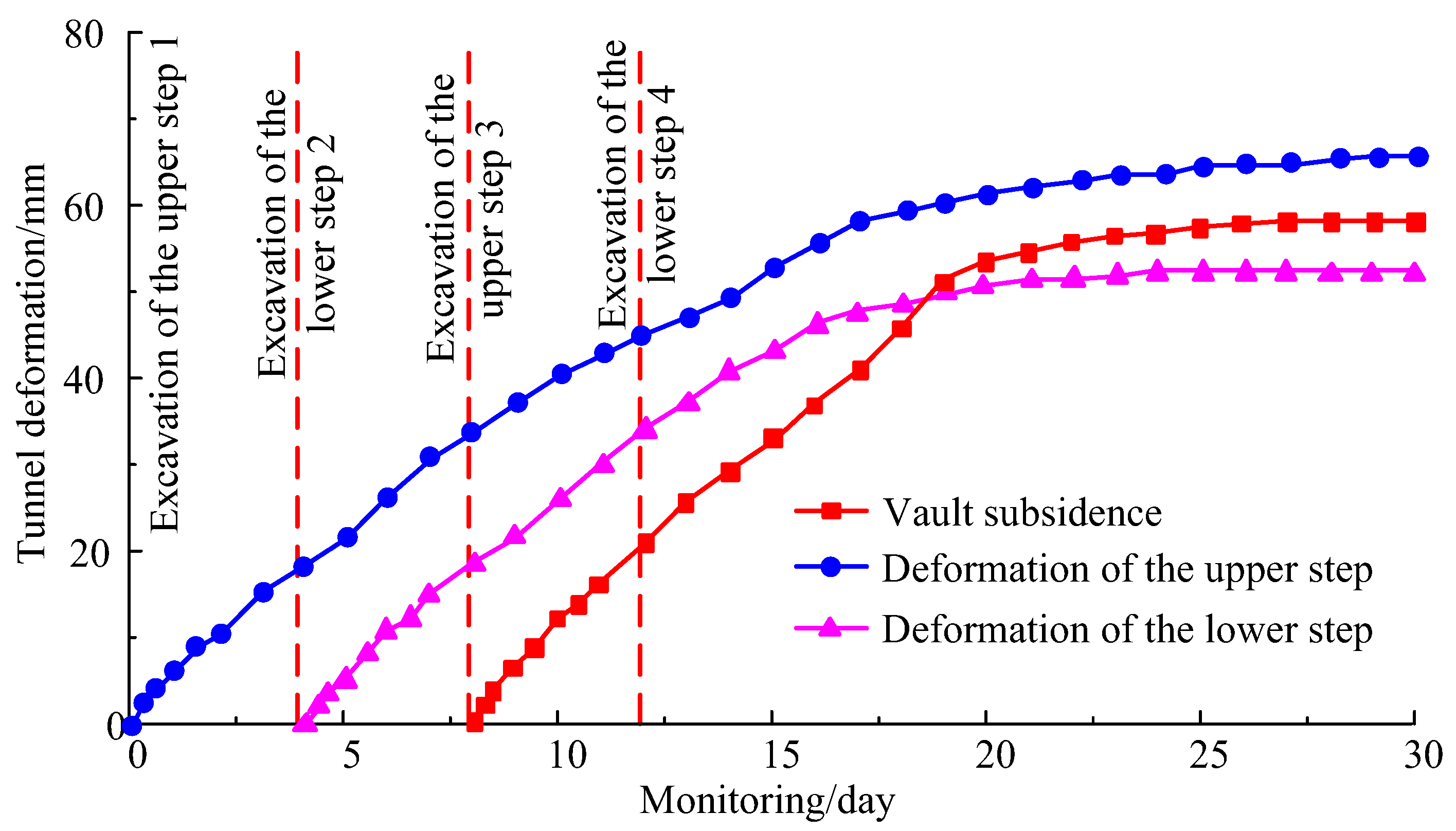

| Surrounding Rock Grade | C25 Shotcrete | Hollow Bolt/Low-Pre-Stressed Bolt | Reinforcing Mesh | Steel Arch | ||||
|---|---|---|---|---|---|---|---|---|
| Thickness/cm | Specification | Length/m | Spacing/m | Specification | Spacing/m | Specification | Spacing/m | |
| V | 29 | Φ25 | 5 | 1.0 × 0.75 | Φ8 | 20 × 20 (double layers) | I22b | 0.75 |
| Name | Elastic Modulus/GPA | Poisson’s Ratio | Density/(kg·m−3) | Cohesion/MPa | Internal Friction Angle/(°) |
|---|---|---|---|---|---|
| Diorite | 0.02 | 0.29 | 1800 | 0.028 | 30 |
| Limestone | 1.7 | 0.35 | 2000 | 0.12 | 25 |
| C25 shotcrete | 26 | 0.2 | 2400 | / | / |
| Steel arch | 210 | 0.3 | 7850 | / | / |
| Surrounding Rock Grade | C25 Shotcrete | Hollow Bolt/Low-Pre-Stressed Bolt | Reinforcing Mesh | Steel Arch | ||||
|---|---|---|---|---|---|---|---|---|
| Thickness/cm | Specification | Length/m | Spacing/m | Specification | Spacing/m | Specification | Spacing/m | |
| V | 35 | Φ25 | 5 | 1.0 × 0.5 | Φ8 | 20 × 20 (double layers) | I28a | 0.5 |
Publisher’s Note: MDPI stays neutral with regard to jurisdictional claims in published maps and institutional affiliations. |
© 2022 by the authors. Licensee MDPI, Basel, Switzerland. This article is an open access article distributed under the terms and conditions of the Creative Commons Attribution (CC BY) license (https://creativecommons.org/licenses/by/4.0/).
Share and Cite
Ding, K.; Wang, L.; Ren, B.; Wang, S.; Jiang, C. Study on Optimization of Initial Support for a Tunnel in the Fracture Zone Based on the Strength Reduction Method. Processes 2022, 10, 1558. https://doi.org/10.3390/pr10081558
Ding K, Wang L, Ren B, Wang S, Jiang C. Study on Optimization of Initial Support for a Tunnel in the Fracture Zone Based on the Strength Reduction Method. Processes. 2022; 10(8):1558. https://doi.org/10.3390/pr10081558
Chicago/Turabian StyleDing, Ke, Lianguo Wang, Bo Ren, Shuai Wang, and Chongyang Jiang. 2022. "Study on Optimization of Initial Support for a Tunnel in the Fracture Zone Based on the Strength Reduction Method" Processes 10, no. 8: 1558. https://doi.org/10.3390/pr10081558
APA StyleDing, K., Wang, L., Ren, B., Wang, S., & Jiang, C. (2022). Study on Optimization of Initial Support for a Tunnel in the Fracture Zone Based on the Strength Reduction Method. Processes, 10(8), 1558. https://doi.org/10.3390/pr10081558








